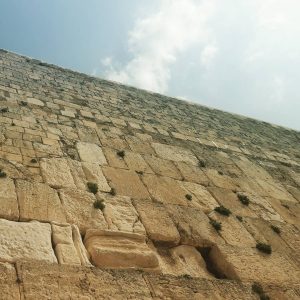Thousands and thousands of visitors from around the world visit the Western Wall all the years. Some visitors stand at the Kotel, i.e. the Wailing Wall, praying, while others tour around to admire the Wall’s maintained lustre and observe the dramatic scene of many people wearing their prayer cloaks whilst praying altogether. The Western Wall is also named the Wailing Wall or the Ha Kotel Ha’ Ma’aravi in Hebrew, and it is located in the core of Jerusalem’s Old City.

Western Wall is considered the Jewish holiest religious site in the world. The Wall is the only outstanding segment of the limestone wall of the Second Jewish Temple, which was constructed by King Herod the Great dating back to the 2nd century BC. The Kotel is the remnant of three structural walls of the Temple Mount, the antique place of the First and Second Jewish Temples.
The Temple Mount is a large rectangular terrace where the Dome of the Rock stands, which is also well-known as the Al-Aqsa Mosque. The Western Wall became a forbidden place for Jews besides the prohibition of entering the Temple Mount. However, the Western Wall was under Jewish control since 1967, and it became the centre of continuous conflicts between Jews and Muslims.
The four entrances to the Western Wall are the Jaffa Gate, the New Gate, the Damascus Gate and the Zion Gate. The Zion Gate is the closest one to the Jewish Quarter and Mount Zion. Tourists who want to visit the Armenian and Christian Quarters should enter through the Jaffa Gate, and the New Gate close to Jaffa Street will lead visitors to the Christian Quarter best. The Damascus Gate is the nearest entrance to the Muslim Quarter. The Old City is a labyrinth of small streets and alleyways crowded with souvenir stores, cafeterias and eateries.

Safety Checks At The Entrance To The Western Wall
Police controls are continuous close to the Western Wall area and the Muslim Quarter. Tourists have to go through a security check, which is guarded by Israeli Border Police. Security checks are regularly performed in few seconds through the use of metal detectors. Additionally, it is recommended to bring some documents of identification before accessing the area.
Moreover, there is a dress code to follow and some behavioural rules to visit the Western Wall. Both women and men should dress modestly. Indeed, as an example, men nearing the prayer section must cover their heads by wearing a Kippa, i.e. a skull cap, a simple hat or a cap. Simple caps are also ready at the entrance to the prayer section.
Every woman approaching the Wailing Wall must dress decorously, ideally wearing a shirt with sleeves and long skirts or trousers. Bare shoulders, mini skirts and shorts are forbidden. Anyway, shawls are available usually at the entrance to the prayer section.
There are also stringent behaviour regulations during Shabbat and Jewish festivals, such as banning smoking, eating, writing, taking photos, and using digital types of equipment, like smartphones.
A Summary Of Rules At The Western Wall
There are different guidelines for behaviour on regular days at the Western Wall, such as:
- It is not allowed to eat.
- It is not allowed to smoke.
- It is not permitted to light candles.
- It is a must to dress appropriately.
- Torah scrolls may not be allowed into the Western Wall Plaza.

On Jewish Shabbat and Holidays, there are other guidelines to follow, such as:
- It is forbidden to use electronic devices.
- It is not permitted to use amplification systems.
- It is not allowed to take pictures.
- It is not allowed to write.
Moreover, some objects and tools are not allowed inside the Western Wall complex, such as:
- Sharp tools.
- Amplification sound systems.
- Balloons and pyrotechnics.
- Shofar (except on the month of Elul and Aseret Yemei Teshuva).
- Musical instruments.
- Alcohol.
- Pieces of equipment for event production.
- Animals (except guide dogs).


